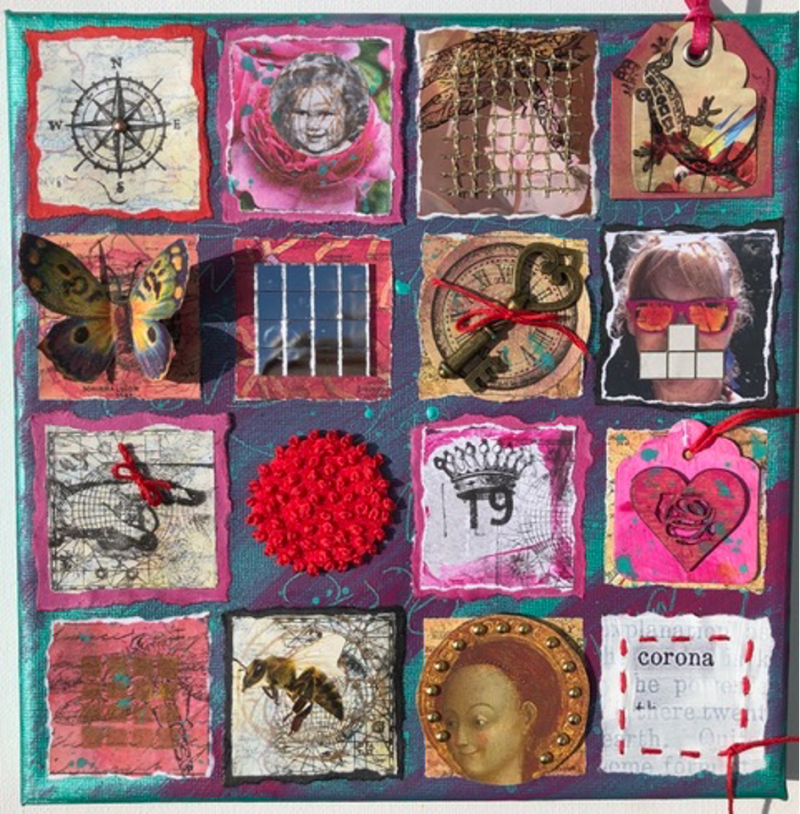The experience of confinement, as an effect of the coronavirus pandemic, is having an impact on the subject. The artist Rosemary Cassidy Buswell (1) shows us, in this regard, how to deal with this real outside meaning (le réel hors sens), the real of confinement.
Through her artistic know-how, she extracts a series of ready-made objects, das Dings, indicating how to deal with the nameless that is revealed by the void. The extracted object attests to its character of object a, whose effect is prominent in the parlêtre. This object interprets the lack of meaning by saturating the hole of the real (le réel hors sens).
As soon as the public health crisis arose, Buswell took part in an artistic tutorial that aimed at dealing with the global imperative to lockdown: she participated in the Creativity in Captivity Quilt project by making two ‘blocks’.
What’s happening in these works of art? How does the artist deal with the threat of death? How do the artist’s singular inventions demonstrate a way to proceed? We can, in particular, question from Buswell’s work the relevance of Lacan’s rereading of the concept of sublimation, in light of a work of art oriented by the real.(2)
The Creativity in Captivity Quilt presents the viewer with a metaphorical representation of the unrepresentable. A set of blocks constitutes a paradigm of sublimation in that it circumscribes and highlights the existence of a void. Thus, Buswell offers us a symbolic configuration that establishes the rim of a hole. In this respect, knowledge is on the artist’s side, in the form of a brief statement that each participant was asked to write.
Artistry comes to treat the real by bordering what remains irrelevant for the artist. Consequently, the artist reveals a piece of what cannot be seen, said, or written.
The singularity of the artist lies in his writing. Does the work of art arise from a sublimation of the drive? By producing an object offered for the jouissance of the viewer we suppose that it allows the artist to enter into a social bond and therefore involves the Other. Or is it rather a question of a sublimation without the involvement of the Other as a realization of a symptom, which would have the value of a sinthome, a singular invention?

Artistic creations, like different versions of humor, are sublimatory, sinthomatic modalities, which, according to Lacan, elevate the object of creation to the dignity of das Ding.(3) The void is determined, in these modalities, because it allows a new knot.
In this regard, sublimation brings satisfaction that is incidental to its purpose. Following Freud and Lacan, the object draws its foundation from the subject’s points of attraction in his world. We can say the object that interests him is, more or less, a reflection of his image.
Today, the contemporary artist precedes us by interpreting common objects. He sets himself apart from the barrier that the Other confers on the value of the image and treats the drive object through an artistry articulated with the signifier. Thus, we can assume that in the block named Corona, the signifier (corona) is a metaphor for the S1 (coronavirus). We suppose that it tries to hide the lack of meaning in the signifying chain. With this block in the Captivity Quilt, the white color represents the vacuum where the red stitch attempts to make a border, that is to say a thread that might link the symbolic, imaginary, and real. G
At a time of crisis when the worst is unleashed, artistry brings the real in line. In this instance, Buswell highlights a way of bordering the real as an experience of confinement. Her artistry dialecticizes what cannot be written. Thus, her artwork shows the viewer a counter-current that opposes the influence of what the death drive embodies.
Rosemary Cassidy Buswell is a British artist who graduated in 1976 from what is now Manchester Metropolitan University with a BA (Hons.) in Textiles and Fine Art, and an MA in Fashion & Textiles in 1977. She taught Textile Design at Blackpool College of Art, and in 1982 moved to Singapore and lectured in Colour Theory and Graphics at the Nanyang Academy of Fine Art. Buswell has worked in various fields of Art and Design, and runs Creative Workshops in England, Singapore, the US, and France.
- Brousse, M-H. (2009). L’objet d’art à l’époque de la fin du Beau, La Cause Freudienne, no. 71, 201-205.
- The Ethics of Psychoanalysis: The Seminar of Jacques Lacan, Book VII (1959-1960). Edited by Jacques-Alain Miller. Translated by Dennis Porter. London: Routledge, 1992.

